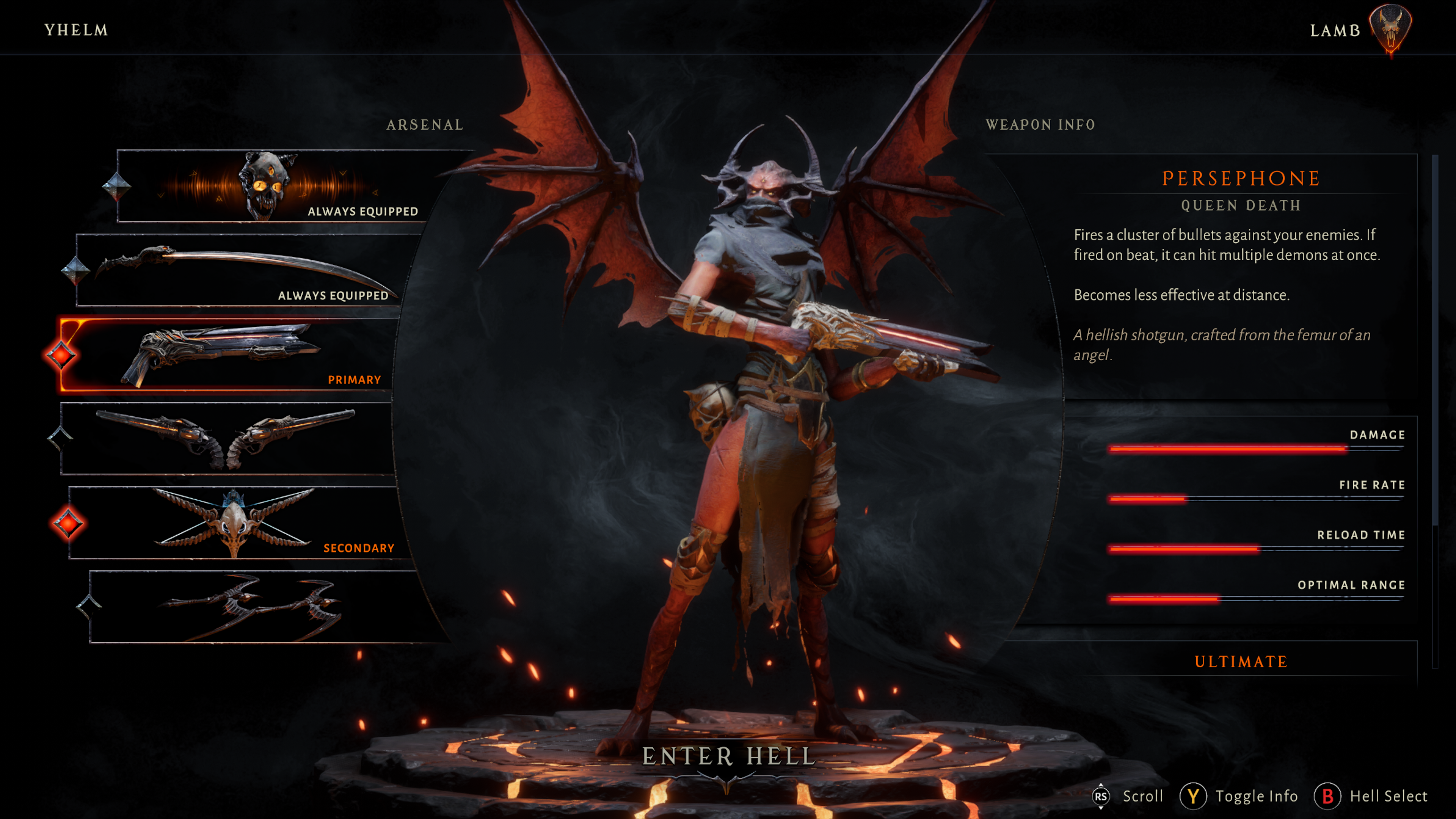Metal: Hellsinger Review (Xbox Series X|S, PS5 & PC)

Metal: Hellsinger is a first-person rhythm-based rock opera that brings the power of heavy metal to a dark and gloomy hellish landscape. Its deep gothic roots, which are highly reminiscent of DOOM's flesh, bone, and cobblestone formula, conjure an otherworldly realm that's rife with bullets, blood, and bruised knuckles. It's only natural, of course, that such a world would attract a community of action-loving headbangers that long for an everlasting crescendo, to which, unsurprisingly, Metal: Hellsinger delivers better than any other game on the current market.
Welcome to Hell

Metal: Hellsinger casts its focus on a female demon who goes by the name of The Unknown. Her purpose, which is to descend into the eight layers of hell in search of her stolen voice, takes you on a romp through a bullet-riddled quest that's evidently rife with twisted executions and an abundance of heavy metal scores. Your goal, alongside the primary objective of locating your voice, is to pursue The Red Judge, a demonic foe that looms in the pits of Sheol.
As this is a first-person shooter that prioritizes mindless violence and destruction over any form of thought-provoking plotline, it's evident from the get-go that this is not, in any way, shape or form, a story-driven game. It's all about the bullets and the brawn, and honestly, that's enough to counter the lack of narration. That is, if you don't mind slugging through a relatively short bullet-soaked labyrinth for four hours straight with nothing but a bit of dialogue to accompany you.
Unfortunately, Metal: Hellsinger isn't the lengthiest game in the world, nor is it exactly swimming in world class innovations. It's bread and butter carnage in short bursts, and by the time you've found your rhythm, which is around the fourth of fifth level, the game is just about ready to draw its final curtain. The only thing that draws you back in, which is a neat little touch, is the leaderboard. By earning points, you gradually ascend the global ranks, which means there's definitely a level of replayability there. That said, with only eight levels and a tutorial to hone your skills in, there isn't a lot of diversity, and it's easy to experience all there is to see and do in a single afternoon on the grind.
Rhythm, Reload, and Recoil

Of course, the thing that sets Metal: Hellsinger apart from its manic first-person shooter cousins is the rhythm-based combat that it employs. Unlike the usual button mashing dramatics that you'd find in a game like, say, for example, Wolfenstein, you have to actually time your attacks in sync with the beat of the soundtrack. And depending on the difficulty setting you choose for each level, this beat can either be continuous, or a few notes apart. Either way, it's very much the case of tapping the trigger whenever the blimp glows a radiant white which, when all's said and done, isn't the most complex task to wrap your head around.
It goes without saying that, shoveling through Metal: Hellsinger is all about racking up points. By performing executions with a variety of weapons in time with the beat, you essentially earn more points. These points — surprise, surprise — get added to a final score, which then gets compared to a global leaderboard. It's a textbook blueprint of most bog-standard arcade shoot 'em ups, only with a monumental helping of heavy metal to pepper over the top.
The Loadout

As with any first-person shooter flick, assembling a powerful weapon loadout is one of the many keys to succeeding in battle. That said, Metal: Hellsinger has just six weapons to choose from, two of which come tied to your core inventory: the Paz, a know-it-all skull that serves as your companion on your travels, and Terminus, a deadly blade that rains havoc down on enemies when its attacks line up with the beat. The other four weapons — a shotgun, dual pistols, a crossbow, and a pair of demonic boomerangs, unlock as you progress deeper into the eight circles of Hell.
Knowing the six weapons and their respective reload times does, of course, mean being able to establish a smoother rhythm when trudging through the endless waves of enemies. That said, I for one found that only the shotgun and the crossbow were capable of syncing up with the beat when fired continuously. The kickback from the other four, on the other hand, disrupted a lot of the patterns. Perhaps it was that, or that, you know, my lack of rhythm couldn't quite string together a proper multiplier.
“If You've Seen One Hell, You've Seen ‘Em All”

As there are only eight levels of Hell to work through, you'd have thought that developer The Outsiders would've drawn up a few more original settings, rather than squeeze blood from the same vein eight times over. To this end, it's a somewhat one-note ordeal, and there isn't one segment of Hell that artistically stands out more than the others. That being said, it's still a beautifully carved game, and it certainly sets the benchmark for modern shooters — even if the vast majority of it is laced with blood and bone.
Progression is very much the same with each template biome, in which you're tasked with fighting through four or five areas, executing hoards of demons, and capping it all off with the same boss, only with a slightly different skin and backdrop. Because of this, not a great deal is left to the imagination, and its conclusion is somewhat painted in black and white long before the prologue lays all of the pieces on the board.
Of course, as you slump your way through the fast-paced environments on a rebellious quest for vengeance, the boss, which is, in essence, a demonic foe that rolls by the name of Judge Aspect, continues to evolve and get tougher. Defeating it in each version of Hell, though, is just the same as any other: lace it with bullets until it's crawling for the hills. Or in this case, another layer of Hell. That's about it, and it's very samey, in spite of its minor effort to switch up the music and scenery.
Thank Heavens for Torment

Beyond the eight layers of Hell that make up the bulk of the game is a whole other library of challenges. These challenges, which are commonly referred to as “Torments,” can be accepted after beating each level. Their purpose, if you can believe, is to help make your time in Hell a little more, say, forgiving. In order to reap the benefits of each Torment, you must engage in a series of time-based tasks. If you complete them in the allotted time, then you receive Sigils, items that can provide additional perks to your loadout weapons.
Acquiring said Sigils to the base game does, of course, add a second layer of content to an otherwise short game. It also helps flesh out the game's limited arsenal, mainly by providing each weapon with a series of features that can assist you when you've hit a brick wall much further down the line. And if there's one thing I came to learn during my romp through the hollow hellhole — it's that brick walls were never exactly in short supply.
While the main campaign will take you anywhere from three to four hours to complete, the Torments will take you much, much longer to overcome. And, if you're one to mold over the leaderboard and pour heart and soul into chipping away at its ranks in an attempt to reach the apex, then Metal: Hellsinger is perhaps one of the best choices you could possibly pick up on today's market. Oh, and it's also on Xbox Game Pass, too, meaning subscribers can experience the whole shebang without having to fork out any weighty fees. Now that's metal.
Verdict

Metal: Hellsinger is a real breath of fresh air for anyone who abides by the first-person shooter code and idolizes the ravenous world of rhythm-based combat. Although somewhat bite-sized and without a real sense of direction, its addictive arcade-style action and dog-eat-dog leaderboard most definitely make it a journey worth embarking on.
Metal: Hellsinger doesn't do quite enough to turn every head in the room. But it does, however, make those already entwined bang them to their heart's content. It is, perhaps, the most metal game you'll ever play, which is saying something given just how many of these types of games there actually are out there. The fact is, though, metalhead or not, it's definitely worth spending some time with — especially when it only asks that you join it for a sprint, and not a marathon.
Call it what you will, but The Outsiders clearly has a deep understanding of what it takes to build a fantastic first-person shooter. It may be short, and it be something of a one-note ordeal, but the fact of the matter is, Metal: Hellsinger is the beating heart of a dying genre, a bastion of pride for both rhythmic shooters and arcade dwellers to hoist.
Metal: Hellsinger Review (Xbox Series X|S, PS5 & PC)
A Romp Through a Hollow Hellhole
Metal: Hellsinger is one of the last remaining cornerstones of rhythm-based shooters. It may be bite-sized and only suitable for a metal-loving demographic, but it’s a romp through a hellhole that most, if not all arcade dwellers will most certainly get a kick out of.











